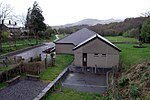Aber Dinlle Fault
Geology of GwyneddUnited Kingdom geology stubsWales geography stubs
The Aber Dinlle Fault is a SW-NE trending fault in North Wales. It forms part of the Menai Strait Fault System, with the Berw and Dinorwic Faults. It lies close to the epicentre of the 1984 Llŷn Peninsula earthquake, although it is not thought to have been responsible for that event. The fault was active during deposition of Ordovician rocks in the Welsh Basin. It was reactivated as a normal fault in the Carboniferous with a downthrow to the northwest and again reactivated as a reverse fault during Late Carboniferous inversion associated with the Variscan Orogeny.
Excerpt from the Wikipedia article Aber Dinlle Fault (License: CC BY-SA 3.0, Authors).Aber Dinlle Fault
A4244,
Geographical coordinates (GPS) Address Nearby Places Show on map
Geographical coordinates (GPS)
| Latitude | Longitude |
|---|---|
| N 53.18 ° | E -4.13 ° |
Address
A4244
LL57 4UU , Pentir
Wales, United Kingdom
Open on Google Maps










